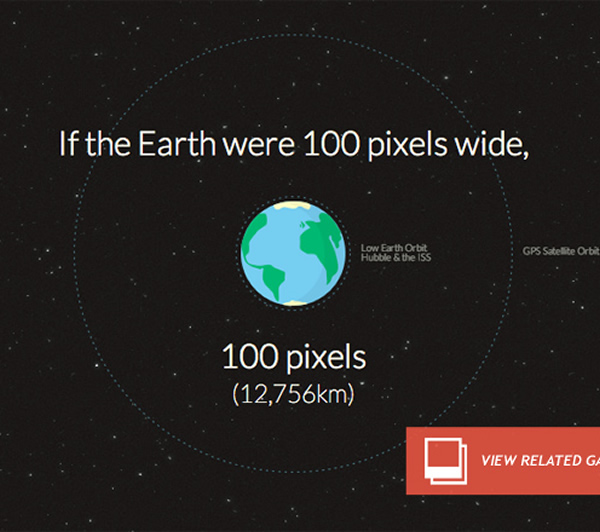How Far to Mars?
We all know the planets are far away. Sometimes closer, sometimes farther, all depending on how their orbits happen to have everything positioned. But in general, to get from here to there is a long, long way.
Let’s say “there” is Mars. The planet right next door. And let’s say “here” is… well, here. Earth. And then let’s say that Earth — the whole thing — is a sphere exactly 100 pixels across. Nice and neat; a size we can all envision pretty easily. (And to make it even easier there’s a 100-pixel Earth right up there, graciously provided free-of-charge by interactive designers David Paliwoda and Jesse Williams.)
If we could embark on a direct straight-shot route to Mars when it’s at its closest, and travel at a rate of 7,000 pixels per second (which is actually a scale velocity of about 3 times the speed of light) how long would it take to get there?
How far away would Mars be if Earth were this big? (Infographic by David Paliwoda)
Click here to find out.
On David’s web page you’ll quickly see that even though Earth and Mars are neighboring worlds and we’ve sent many robotic exploration missions there — some successfully, some not-so-much — it’s still a very long way away. Even at its closest, Mars is still around 40 million miles (56 million kilometers) away. That’s about 170 times the distance to the moon!
And other times — like right now — the Earth and Mars are on totally opposite sides of the sun, separated by 225 million miles (362 million km). You definitely wouldn’t want to try for a direct trip then.
In fact, engineers of the MSL mission won’t even send commands to the Curiosity rover right now — there’s too much of a chance of corruption by solar interference. So for a couple of weeks Curiosity is on its own, working from prerecorded commands on low-risk projects… i.e. no driving!
Of course, when MSL went to Mars it didn’t go on a direct route (and it certainly wasn’t traveling anywhere near relativistic speeds). Instead, it gradually spiraled outwards in an ever-widening orbit over the course of 8 months and 11 days, arriving at Mars on August 6, 2012, after 352 million miles (567 million km) of space travel.
And, as David notes in his animation, the shortest time we can expect a manned trip to Mars to take with current technology is about 150 days. Again, that’s at nowhere near light speed. (50,000mph may be fast, but light is still a lot faster.)
Now all we have to do is get those darn warp drives built…
Apr 9, 2013 11:30 AM ET by Jason Major












